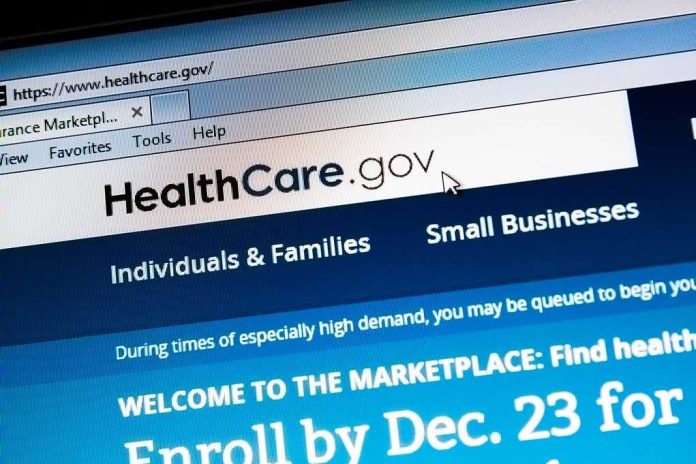
California’s bold decision to spend $6.4 billion a year on healthcare for undocumented immigrants has transformed the state into an ideological battleground—leaving everyone from taxpayers to policymakers asking, “How far can generosity go before budgets break?”
Story Snapshot
- California is the first and only state to offer comprehensive Medicaid coverage to all income-eligible undocumented residents.
- The price tag: $4–$6.4 billion annually, sparking fierce debates on fiscal priorities and immigration policy.
- Budget shortfalls have triggered new enrollment freezes and premium requirements for undocumented enrollees starting in 2026.
- The policy’s scale, impact, and controversy have made California ground zero in America’s battle over healthcare equity and fiscal responsibility.
California’s Grand Healthcare Experiment: The Nation Watches
California did not tiptoe into the healthcare fray. Instead, its leaders, with a Democratic supermajority in the legislature, have redefined what’s possible by making every income-eligible undocumented resident eligible for full-scope Medi-Cal coverage. This expansion unfolded gradually, starting with children in 2015, then young adults and seniors, and finally, in 2024, extending to every undocumented adult who meets income requirements. The move is unprecedented in scale and ambition, rendering California the gold standard—or cautionary tale—depending on whom you ask.
The cost of compassion is staggering. The most recent figures peg the annual tab at $6.4 billion, a sum that rivals or exceeds the entire budgets of many U.S. states. While advocates trumpet the policy as a moral and public health victory, critics say it sets a precedent that could destabilize state finances and incentivize illegal immigration. As budget analysts warn of an $11.9 billion deficit, every dollar spent on healthcare for undocumented residents is now scrutinized under a fiscal microscope.
Rising Costs, Rising Tensions: The Policy’s Breaking Point
California’s healthcare expansion has not been without growing pains. The Legislative Analyst’s Office has repeatedly flagged higher-than-expected costs, driven by a surge in enrollment and increased spending per enrollee. In March 2024, the state had to inject $3.4 billion in loans into Medi-Cal just to keep up. Facing an ever-widening budget gap, Governor Newsom’s May 2024 budget revision included proposals to freeze new Medi-Cal enrollments for undocumented adults starting in 2026 and introduce a $30 monthly premium for those with unsatisfactory immigration status by 2027. These measures are projected to save $3.3 billion annually, but advocacy groups warn they could leave vulnerable populations stranded without access to care.
The policy’s immediate impact is undeniable: 1.6 million undocumented Californians now rely on Medi-Cal for healthcare. Yet looming changes threaten to reverse these gains. The enrollment freeze and premiums could increase the uninsured rate among undocumented adults, exacerbating health disparities, especially among Black and Latino residents who already face barriers to care. The debate over who deserves a safety net—and who foots the bill—has never been more urgent.
Stakeholders, Showdowns, and the Limits of Progressive Ambition
The Democratic supermajority and Governor Newsom have championed equity and public health, even as fiscal watchdogs like the Legislative Analyst’s Office raise red flags on sustainability. Advocacy groups mobilize at every sign of a rollback, arguing that healthy immigrant communities strengthen the entire state. Meanwhile, fiscal conservatives and many taxpayers question the wisdom of prioritizing undocumented residents over other pressing needs, especially as California’s deficit swells.
Other states have watched with a mix of envy and skepticism. While New York and Illinois have piloted limited coverage for certain undocumented groups, no state matches California’s comprehensive approach. In the short term, California’s model delivers tangible health benefits and reduces uncompensated care for hospitals. The question remains: Can any state absorb costs on this scale without cutting services elsewhere or raising taxes? The coming years will test the limits of both political will and fiscal reality.
America’s Policy Laboratory: What Comes Next?
California’s experiment is far from over. The freeze on new enrollments and the imposition of premiums are set to take effect in 2026 and 2027, respectively. If costs keep rising or if budget deficits worsen, deeper cuts could follow. The policy’s legacy will hinge on whether the state can balance compassion with fiscal discipline—and on whether voters continue to support such ambitious spending in tough times.
For now, California stands alone, both as a beacon for progressives and a lightning rod for critics. The stakes are enormous: the health of millions, the solvency of the state, and the nation’s evolving sense of responsibility to those living in the shadows. As lawmakers, advocates, and taxpayers wrestle with these dilemmas, one thing is clear—California’s healthcare gambit is shaping not just its own future, but the contours of America’s debate over immigration, equity, and the social contract itself.
Sources:
California Pan-Ethnic Health Network: State Budget Update
Legislative Analyst’s Office: Medi-Cal in the May Revision
California Budget & Policy Center: First Look at the Governor’s 2025-26 May Revision







